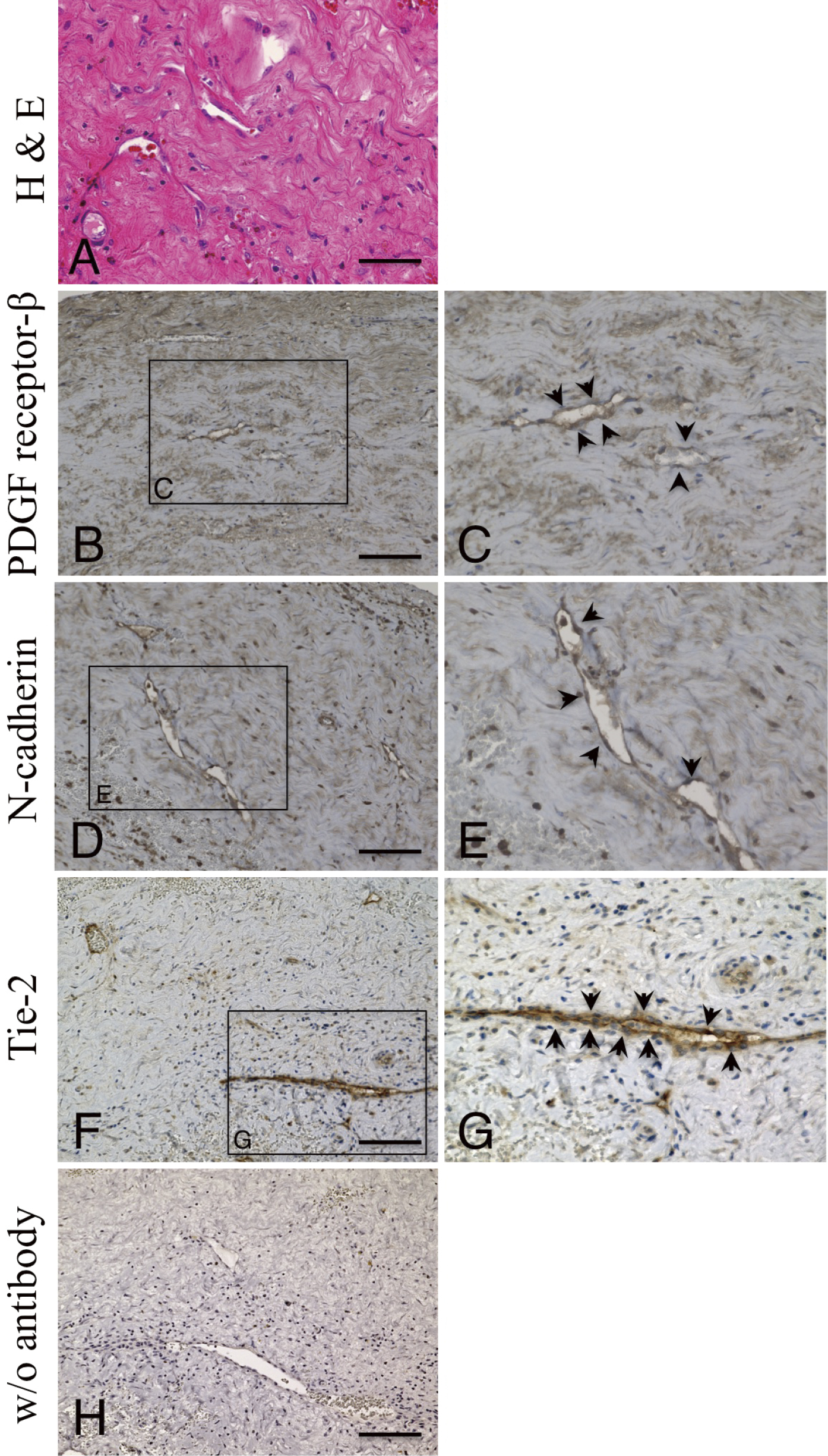- 著者
- Mao YOKOTA Koji OSUKA Yusuke OHMICHI Mika OHMICHI Chiharu SUZUKI Masahiro AOYAMA Kenichiro IWAMI Satoru HONMA Shigeru MIYACHI
- 出版者
- The Japan Neurosurgical Society
- 雑誌
- Neurologia medico-chirurgica (ISSN:04708105)
- 巻号頁・発行日
- pp.2023-0079, (Released:2023-11-30)
- 参考文献数
- 27
Angiogenesis is one of the growth mechanisms of chronic subdural hematoma (CSDH). Pericytes have been implicated in the capillary sprouting during angiogenesis and are involved in brain ischemia and diabetic retinopathy. This study examined the pericyte expressions in CSDH outer membranes obtained during trepanation surgery. Eight samples of CSDH outer membranes and 35 samples of CSDH fluid were included. NG2, N-cadherin, VE-cadherin, Tie-2, endothelial nitric oxide synthase (eNOS), platelet-derived growth factor (PDGF) receptor-β (PDGFR-β), a well-known marker of pericytes, phosphorylated PDGFR-β at Tyr751, and β-actin expressions, were examined using western blot analysis. PDGFR-β, N-cadherin, and Tie-2 expression levels were also examined using immunohistochemistry. The concentrations of PDGF-BB in CSDH fluid samples were measured using enzyme-linked immunosorbent assay kits. NG2, N-cadherin, VE-cadherin, Tie-2, eNOS, PDGFR-β, and eNOS expressions in CSDH outer membranes were confirmed in all cases. Furthermore, phosphorylated PDGFR-β at Tyr751 was also detected. In addition, PDGFR-β, N-cadherin, and Tie-2 expressions were localized to the endothelial cells of the vessels within CSDH outer membranes by immunohistochemistry. The concentration of PDGF-BB in CSDH fluids was significantly higher than that in cerebrospinal fluid. These findings indicate that PDGF activates pericytes in the microvessels of CSDH outer membranes and suggest that pericytes are crucial in CSDH angiogenesis through the PDGF/PDGFR-β signaling pathway.
- 著者
- Takahiro Matsuo Fumika Taki Daiki Kobayashi Torahiko Jinta Chiharu Suzuki Akiko Ayabe Fumie Sakamoto Kazuyo Kitaoka Yuki Uehara Nobuyoshi Mori Tsuguya Fukui
- 出版者
- Japan Society for Occupational Health
- 雑誌
- Journal of Occupational Health (ISSN:13419145)
- 巻号頁・発行日
- vol.63, no.1, pp.e12247, 2021 (Released:2021-09-25)
- 参考文献数
- 43
- 被引用文献数
- 22
Objectives: To determine the prevalence of burnout according to job category after the first wave of COVID-19 in Japan and to explore its association with certain factors.Methods: An online cross-sectional survey of health care workers (HCWs) from June 15 to July 6, 2020, was conducted at a tertiary hospital in Tokyo, Japan. Demographic characteristics, results of the Japanese version of the Maslach Burnout Inventory-General Survey, types of anxiety and stress, changes in life and work after the peak of the pandemic, and types of support aimed at reducing the physical or mental burden, were determined.Results: Of 672 HCWs, 149 (22.6%) met the overall burnout criteria. Burnout was more prevalent in women (OR, 3.11; 95% CI, 1.45-6.67, P = .003), anxiety due to unfamiliarity with personal protective equipment (PPE) (OR, 1.98; 95% CI, 1.20-3.27, P = .007), and decreased sleep duration (OR, 1.96; 95% CI, 1.20-3.20, P = .008). Conversely, participants who felt that the delivery of COVID-19-related information (OR, .608; 95% CI, .371-.996, P = .048) and PPE education opportunities (OR, .484; 95% CI, .236-.993, P = .048) and messages of encouragement at the workplace (OR, .584; 95% CI, .352-.969; p = .037) was helpful experienced less burnout.Conclusions: There is a need to focus on the above factors to maintain the mental health of HCWs. The delivery of COVID-19-related information and educational interventions for PPE and messages of encouragement at the workplace may be needed to reduce the mental burden.
